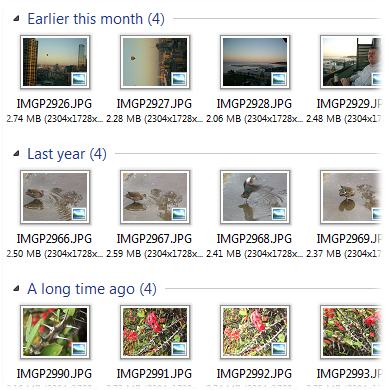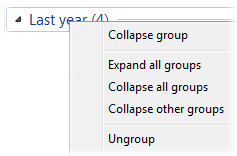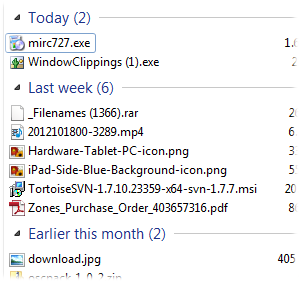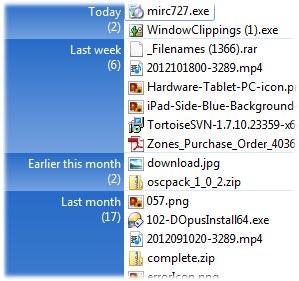Sorting and Grouping
You can control the order files and folders are displayed in several
different ways. The primary way is by defining the sort order. A file
list can be sorted by any column that is currently displayed.
In details and power mode, you can change the sort order by clicking the
desired sort field in the column header.

If the field you
want to sort by is not currently displayed in the list, use the Folder Options dialog to
add the desired column. This applies even in the non-column based view modes -
even if the column is not displayed, it must still be added to the folder format
before you can sort by it.
Clicking on a field will sort the list by that field. If you click the same
field again, the sort order will be reversed. You can go straight to the reverse
order for the field by holding the Shift key down when you
click it. You can sort by multiple fields (as shown in the image above) by
holding the Ctrl key down. Select the first (primary) sort
field by clicking normally, then hold the Ctrl key and click on
the second field, third field, fourth field and so on. The direction for
supplementary sort fields can be modified on an individual basis in the same way
as for the primary field.
In the non-column based view modes, the easiest way to change the sort order
is to right-click on the background of the file display (an empty area - or
right-click on the status bar if you can't find an empty area) and select the
desired sort field from the context menu. You can also use the Folder
Options dialog to change the sort order. There are several other
options in the Folder
Options dialog that affect the order of items in the list - for
example, you can choose whether files should come before or after folders, or if
the two should be mixed together.
Grouping lets you split the list of files into multiple groups (fairly
obviously!). You can group by the same column that you sort by, or by a
completely different column. Unlike sorting, the column you group by
doesn't have to be currently displayed - although the grouping context menus
described below will only display those columns that are currently
enabled. To group by a non-displayed column you need to use the
internal Set GROUPBY
command.

In this screenshot, the list has been grouped by last modified date. Each
group has a heading that identifies the content of the group and displays the
number of items in the group. You can collapse (hide) or expand (reveal) the
contents of the group by clicking the little  glyph (or with the
keyboard, place the focus on the group header and press the
Cursor Left key to collapse it, or Cursor
Right to expand it).
glyph (or with the
keyboard, place the focus on the group header and press the
Cursor Left key to collapse it, or Cursor
Right to expand it).
To group (or ungroup) the list, right click on the column header (or, in a
non-column based view mode, right-click an empty area of the file display or the
status bar) and select the desired field from the Group By
menu. You can also use the column header to set the grouping field by holding
the Alt key down and clicking the desired field. If you click
it a second time (with the Alt key down) the grouping direction
will be reversed. Grouping can be disabled altogether by holding
Shift+Alt and clicking any field in the header.
Clicking a group header will automatically select all files in that group. If
you right-click a group header, a number of grouping-related commands are
displayed in the context menu.

Collapse group (or Expand group) lets you
collapse (or expand) the group you clicked on. Expand all groups
, Collapse all groups and Collapse other
groups affect all groups at once.
As an alternative to the group appearance shown above (with headers
separating each group vertically), the Group column can be added to the
file display (via the Folder Options dialog). When this column is present in a grouped file display, the column
itself displays the headings, making for a much more compact display.


Traditional
group
headings Group
column
The colors used for the Group column can be
configured on the Display / Colors and Fonts
Preferences page. You can define different colors for source and destination
file display if desired. You can also configure Opus to add the Group
column automatically whenever the file display is grouped with the Folders /
Folder Display / Add 'Group' column automatically when file display is
grouped option.


 glyph (or with the
keyboard, place the focus on the group header and press the
Cursor Left key to collapse it, or Cursor
Right to expand it).
glyph (or with the
keyboard, place the focus on the group header and press the
Cursor Left key to collapse it, or Cursor
Right to expand it).

